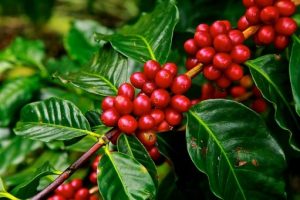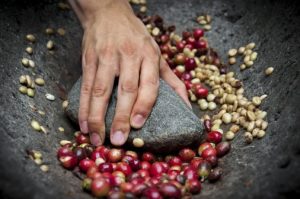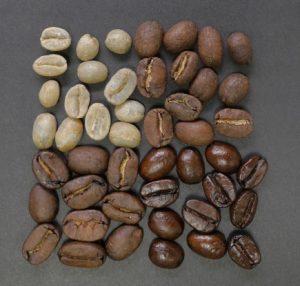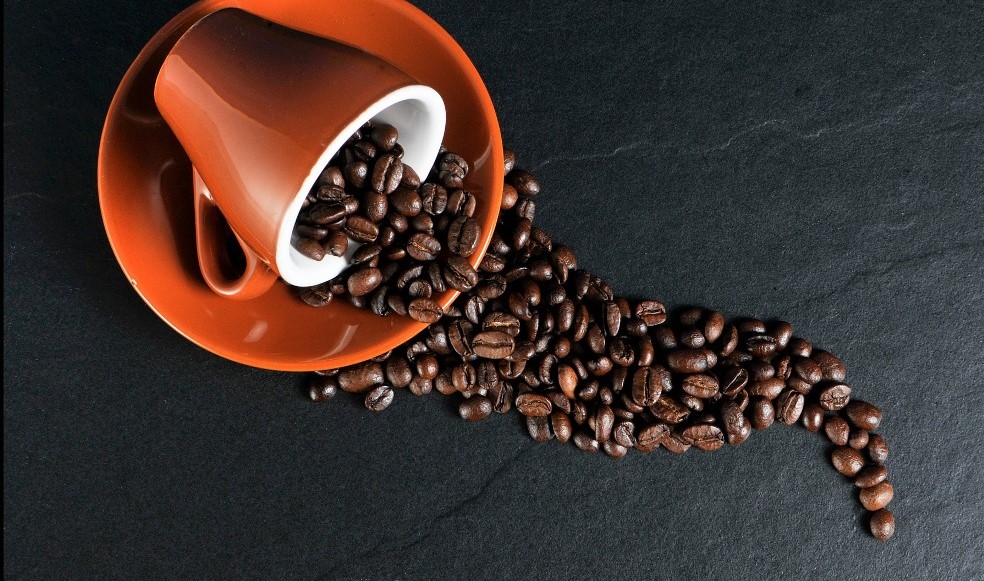History
There are many myths surrounding the discovery of coffee as a stimulating beverage. The best known story is that of a Maronite Monk from the former Kaffa Province in the highlands of Ethiopia who listened to the complaints made by goatherds. They spoke about the fact that some of their goats never showed any sign of weariness. He investigated the issue and discovered that the goats which were always full of energy had previously nibbled at a plant with green, yellow and red cherries – the coffee plant. The monk brewed himself a drink using the plant and found that any feeling of tiredness also completely disappeared [1].
 Coffee has meanwhile become so embedded in our culture that it is hard to imagine life without it. The original Old Arabic word “qahwa” expresses the concept of vitality or strength, and was also used as the word for wine. This gives some indication of the great relevance this small bean has always had (a further explanation is that the bean-based drink took on the name of wine because the latter is forbidden in the Islamic faith) [2]. Actually the term “bean” is incorrect from a botanical perspective – the drink is really made from the roasted seeds of the coffee plant. The genus of Coffea consists of some 70 types, although the best known and most common globally are Coffea arabica and Coffea canephora var. robusta [3]. The coffee plant is thought to originally come the country we know as Ethiopia today, from where it then spread around the world. These days, the main cultivation areas are in Brazil, Vietnam and Columbia [4].
Coffee has meanwhile become so embedded in our culture that it is hard to imagine life without it. The original Old Arabic word “qahwa” expresses the concept of vitality or strength, and was also used as the word for wine. This gives some indication of the great relevance this small bean has always had (a further explanation is that the bean-based drink took on the name of wine because the latter is forbidden in the Islamic faith) [2]. Actually the term “bean” is incorrect from a botanical perspective – the drink is really made from the roasted seeds of the coffee plant. The genus of Coffea consists of some 70 types, although the best known and most common globally are Coffea arabica and Coffea canephora var. robusta [3]. The coffee plant is thought to originally come the country we know as Ethiopia today, from where it then spread around the world. These days, the main cultivation areas are in Brazil, Vietnam and Columbia [4].
Health and nutrition
For many years coffee held the reputation of being unhealthy, of making people nervous and unsettled and even having a negative impact on longevity. The latter has meanwhile been disproved. In investigations researchers neglected to take into account the general lifestyle habits of the study participants – as many coffee drinkers were also smokers this led to distorted findings. If this factor is taken into account, consumption of coffee is actually correlated with lower overall mortality. The increased nervousness which some people experience after drinking coffee stems from a property of caffeine, which docks onto the adenosine receptors in our bodies. Consequently, it suppresses the messenger substance adenosine which usually triggers tiredness. Caffeine also increases the heart rate and concentration levels, and also expands bronchial tubes [5].
Another preconception is that coffee removes water from the body. This is because of the diuretic effect of constituents such as caffeine, and methylxanthines such as theophylline and theobromine. It has transpired that a quantity of c. 250-300mg of caffeine (equivalent to roughly 2 to 3 cups of coffee) consumed in one go leads to an increased urge to urinate. With regular consumption, however, the body develops a tolerance against this diuretic effect [5]. Up to four cups of coffee per day can be tolerated by our bodies according to the Deutsche Gesellschaft für Ernährung (German Nutrition Society). Exceptions to this, of course, apply to persons with impaired health and pregnant women [6].
This is because of the diuretic effect of constituents such as caffeine, and methylxanthines such as theophylline and theobromine. It has transpired that a quantity of c. 250-300mg of caffeine (equivalent to roughly 2 to 3 cups of coffee) consumed in one go leads to an increased urge to urinate. With regular consumption, however, the body develops a tolerance against this diuretic effect [5]. Up to four cups of coffee per day can be tolerated by our bodies according to the Deutsche Gesellschaft für Ernährung (German Nutrition Society). Exceptions to this, of course, apply to persons with impaired health and pregnant women [6].
There is a divergence of opinion concerning the impact of coffee consumption on the human organism. Whilst a number of studies demonstrate, for example, the positive effect of a high consumption of caffeine in the case of headaches or (chronic) migraines, other studies reveal a possible connection to an increased risk of chronic headaches [7].
Another investigation from the start of this year, however, showed that small quantities of caffeine can have an anti-depressant effect as well as bring about an improvement in the mental capabilities of patients with depression [8].
The polyphenols (also secondary plant substances) in coffee are also believed to stimulate the autophagy of our cells. This is a type of recycling programme carried out by our bodies in which defective components of cells are removed and re-used [9]. This process is connected, for example, to a protective effect against diseases such as certain types of cancers, infections, metabolic functions such as diabetes, neuro-degenerative and chronic inflammatory disorders [10]. Unfortunately, there is bad news for anyone who only enjoys their coffee with a dash of milk: animal-proteins are suspected of hindering the autophagic processes. In the case of plant-based milk, such as almond milk, in contrast, this type of a hindering effect could not be observed [9].
 The potential cancer-preventing properties of coffee have been the subject of research for many years. Accordingly, the large-scale, long-term European study “EPIC 2014” ascertained up to a 72% reduced risk of developing hepatocellular carcinoma (liver cancer) in test persons with an increased consumption of coffee. [11] [12]. In a further study published recently, the potential protective effect of coffee consumption in relation to the risk of developing basel cell cancer was also proven [13].
The potential cancer-preventing properties of coffee have been the subject of research for many years. Accordingly, the large-scale, long-term European study “EPIC 2014” ascertained up to a 72% reduced risk of developing hepatocellular carcinoma (liver cancer) in test persons with an increased consumption of coffee. [11] [12]. In a further study published recently, the potential protective effect of coffee consumption in relation to the risk of developing basel cell cancer was also proven [13].
On the other hand, there are warning voices which refer to the constituents acrylamide and furan. These substances develop during the roasting of coffee beans and, in animal tests, have been classified as carcinogenic and genetically harmful [14]. However, in 2016 the International Agency for Research on Cancer (IARC), in collaboration with the World Health Organisation (WHO), gave the “all-clear” on this issue after reviewing over 1000 studies on this topic: there is no conclusive evidence for a carcinogenic effect of drinking coffee. Consuming coffee actually seems to protect against some types of tumours. The WHO did add one qualification to this, however, which is that drinking very hot beverages probably causes cancer of the oesophagus in humans [15].
Conclusion:
 Coffee has health-promoting properties but seems to be a bit of a double-edged sword. Depending on the constitution of the coffee drinker, it can lead to alertness and concentration or to nervous outbreaks of perspiration. Despite the potential protective effect in terms of a few tumour types, someone who not developed a taste for the drink should not be encouraged to start drinking it. All those who appreciate a good coffee, however, will perhaps enjoy it even more so after reading this article. Nevertheless, it remains to be said that the conditions under which coffee is produced play an important role. An excellent coffee certainly tastes even better if produced under socially sustainable conditions.
Coffee has health-promoting properties but seems to be a bit of a double-edged sword. Depending on the constitution of the coffee drinker, it can lead to alertness and concentration or to nervous outbreaks of perspiration. Despite the potential protective effect in terms of a few tumour types, someone who not developed a taste for the drink should not be encouraged to start drinking it. All those who appreciate a good coffee, however, will perhaps enjoy it even more so after reading this article. Nevertheless, it remains to be said that the conditions under which coffee is produced play an important role. An excellent coffee certainly tastes even better if produced under socially sustainable conditions.
Sources:
[1] Deutscher Kaffeeverband e.V., „Die Entdeckung der Kaffeepflanze,“ http://www.kaffeeverband.de/kaffeewissen/kaffeekultur/geschichte/entdeckung-der-kaffeepflanze.
[2] N. Osman, Kleines Lexikon deutscher Wörter arabischer Herkunft, Bd. 456, C.H.Beck, 2010.
[3] J. Wintgens, Coffee: Growing, Processing, Sustainable Production: A Guidebook for Growers, Processors, Traders, and Researchers, W. Verlag, Hrsg., 2004.
[4] Deutscher Kaffeeverband e.V. , „Kaffeeanbau,“ http://www.kaffeeverband.de/kaffeewissen/von-der-pflanze-zur-bohne/kaffeeanbau.
[5] M. Melzer, „Kaffee: Gesund, oder ungesund?,“ Apotheken-Umschau, 29 Dez 2015.
[6] G. J. Maughan RJ, „Caffeine ingestion and fluid balance: a review,“ J Hum Nutr Diet, Bd. 16, Nr. 6, pp. 411-420, 2003.
[7] Deutsche Gesellschaft für Ernährung, „Presseinformation: Presse, DGE aktuell,“ 30 07 2015. https://www.dge.de/presse/pm/bei-grosser-hitze-ausreichend-fluessigkeit-fuer-senioren/
[8] Hagen K, et a.; „High dietary caffeine consumption is associated with a modest increase in headache prevalence: results from the Head-HUNT Study.,“ J Headache Pain, Bd. 10, Nr. 3, pp. 153-9, Jun 2009.
[9] Liu,Q et al.; „Low dose of caffeine enhances the efficacy of antidepressants in major depressive disorder and the underlying neural substrates,“ Mol. Nutr. Food Res, Jan 2017.
[10] Pietrocola F, et al. „Coffee induces autophagy in vivo,“ Cell Cycle, Bd. 13, Nr. 12, pp. 1987-1994, Apr 2014.
[11] B. Levine, M. Packer und P. Codogno, „Development of autophagy inducers in clinical medicine,“ J Clin Invest., pp. 14-24, Jan 2015.
[12] Bamia C, et al. „Coffee, tea and decaffeinated coffee in relation to hepatocellular carcinoma in a European population: Multicentre, prospective cohort study,“ Int J Cancer., Bd. 136, Nr. 8, pp. 1899-908, Apr. 2015.
[13] Aleksandrova K., et al., „The association of coffee intake with liver cancer risk is mediated by biomarkers of inflammation and hepatocellular injury: data from theEuropean Prospective Investigation into Cancer and Nutrition,“ Am J Clin Nutr, Bd. 102, Nr. 6, pp. 1498-508, Dec 2015.
[14] Caini S, et al. „Coffee, tea and caffeine intake and the risk of non-melanoma skin cancer: a review of the literature and meta-analysis.,“ Eur J Nutr, Bd. 56, Nr. 1, pp. 1-12, Feb 2017.
[15] Öko-Test, „Kaffee – Wer handelt fair?,“ 2014. http://www.oekotest.de/cgi/index.cgi?artnr=102891&bernr=04.
[16] International Agency for Resaerch on Cancer/ World Health Organization, „IARC Monographs evaluate drinking coffee, maté, and very hot beverages – press release N°244,“ 15 Jun 2016. https://www.iarc.fr/en/media-centre/pr/2016/pdfs/pr244_E.pdf.
